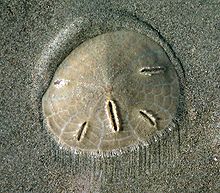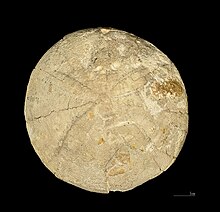Neognathostomata
| Neognathostomata Temporal range:
| |
|---|---|

| |
| Echinocyamus pusillus | |
| Scientific classification | |
| Kingdom: | Animalia |
| Phylum: | Echinodermata |
| Class: | Echinoidea |
| Infraclass: | Irregularia |
| Superorder: | Neognathostomata Smith, 1981 |
| Orders | |
|
Cassiduloida | |
The Neognathostomata are a superorder of sea urchins.
Description and characteristics[]
They are distinguished from other sea urchins by their irregular shape and a highly modified feeding lantern. The group includes the well known sand dollars, as well as some less familiar and extinct forms.
Taxonomy[]

Test of a Clypeaster reticulatus ().

("sand dollar").

Fossil of an ().
- familia Apatopygidae Kier, 1962
- familia Cotteau & Triger, 1869 †
- order Cassiduloida
- Super-familia (Philip, 1963b)
- familia Cassidulidae (L. Agassiz and Desor, 1847)
- Super-familia (Philip, 1963b)
- familia Neolampadidae (Lambert, 1918a)
- familia (Kier, 1962) †
- Super-familia (Philip, 1963b)
- order Clypeasteroida A.Agassiz, 1872 ("sand dollars")
- sous-order
- familia Clypeasteridae L. Agassiz, 1835
- familia Philip & Foster, 1971 †
- familia Irwin, 1995 †
- familia von Zittel, 1879 †
- familia Faujasiidae Lambert, 1905 †
- familia Duncan, 1889 †
- familia Lambert, 1905 †
- sous-order
- infra-order
- familia Echinocyamidae Lambert & Thiéry, 1914
- familia Fibulariidae Gray, 1855
- familia Laganidae Desor, 1858
- infra-order
- familia Echinarachniidae Lambert in Lambert & Thiéry, 1914
- familia Durham, 1955 †
- familia Durham, 1955 †
- familia Rotulidae Gray, 1855
- super-familia Gray, 1825
- familia Durham, 1955 †
- familia Astriclypeidae Stefanini, 1912
- familia Dendrasteridae Lambert, 1900
- familia Mellitidae Stefanini, 1912
- familia Lahille, 1896 †
- familia Durham, 1955 †
- familia Scutellidae Gray, 1825
- familia Taiwanasteridae Wang, 1984
- familia Pomel, 1888a †
- infra-order
- sous-order
- familia Clypeidae Lambert, 1898 †
- familia Clypeolampadidae Kier, 1962 †
- order
- familia Echinolampadidae Gray, 1851a
- familia L. Agassiz & Desor, 1847 †
- familia Lambert, 1905 †
- genus Saucède, Dudicourt & Courville, 2012 †
References[]
- Barnes, Robert D. (1982). Invertebrate Zoology. Philadelphia, PA: Holt-Saunders International. p. 981. ISBN 0-03-056747-5.
- Kroh A, Mooi R (eds.). "Neognathostomata". World Echinoidea Database. World Register of Marine Species.
Categories:
- Echinoidea
- Echinoidea stubs
